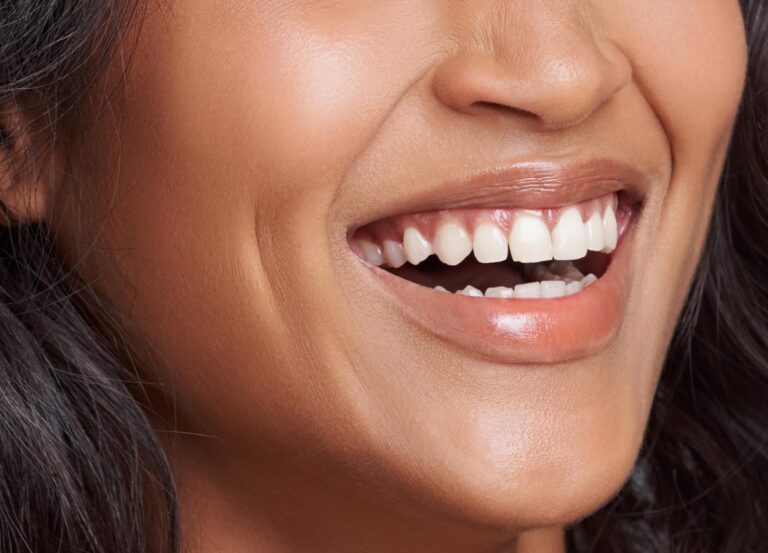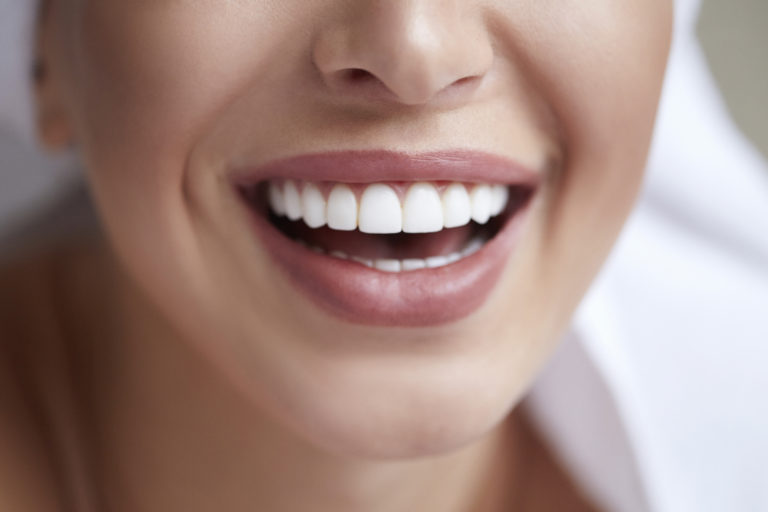Years ago, a crooked smile could seal your fate, sentencing you to years of “metal-mouth” braces, rubber bands and spacers. The advent of Invisalign, in 1997, granted a reprieve, changing the way we think about orthodonture with a seemingly simple concept: a series of clear aligners that patients swap out every one to two weeks to straighten their teeth, close gaps, address crowding and tackle bite issues. The custom aligners, or trays, made of a flexible plastic, fit snugly over the teeth and gradually adjust their position. To get the benefits of the prescription treatment, these aligners are developed and administered under professional care and are to be worn 22 hours a day—removed only when eating, drinking or brushing/flossing.
Recently, a number of invisible aligner startups have come onto the scene—namely, SmileDirectClub, Candid and byte—putting orthodontic care directly in the hands of patients, with appointment-free mail-order products that promise to save us time and money.
New York City–based dentist Dr. Inna Chern sees the emergence of all these DIY systems as a sign of the public’s growing desire for straighter, healthier smiles. “Straighter teeth provide better function and hygiene, improving masticatory function and periodontal health—which reaps systemic health benefits as well,” she says.
“But tooth movement is a serious dental procedure and, if done incorrectly, can wreak havoc on a person’s bite, temporomandibular joint [TMJ] and ability to breathe, in some cases,” she adds. “The fine print for [these direct-to-consumer] companies has clauses leaving them not responsible for the potential damage they cause. I consider this DIY orthodontics, and that is a very risky endeavor.”
So what are the differences between brands? And is the elimination of in-office dental supervision an advantage or a liability? We take a deep dive into the less-than-transparent world of invisible aligners.
Related: What Is Dental Anxiety, and Can You Overcome Your Fear?
The Big Players
Provider-Administered
Invisalign
Cost: $3,000–$7,000 for 6- to 18-month treatments
RealSelf “Worth It” Rating: 92%
The O.G. of invisible aligners, Invisalign’s hallmark is expert involvement: the treatment is prescribed and administered by a provider (an orthodontist, general dentist or cosmetic dentist), touting “in-office treatments with real doctors” front and center on their website. It can address mild to complex issues concerning the teeth and jaw, including crowding, spacing, gaps, overbite, underbite and crossbite. Following a thorough exam and consultation (usually involving photographs, panoramic X-rays and teeth charting), a dental professional clearly maps out a plan and monitors progress, every 10 weeks or so, throughout treatment.
Invisalign goes beyond just plastic aligners. Most recipients also wear attachments—transparent or tooth-colored handles that are bonded to the teeth in a very specific and customized way. The aligners grip onto these nubs, helping teeth move more efficiently and allowing for more complex manipulations, such as rotations or vertical height adjustments. “Aligners have a tendency to slide off the tooth—like how a watermelon seed can easily slip out of your hand,” explains Alexandria, Virgina, orthodontist Dr. Justin Hughes. “The tray alone can’t achieve certain movements, unless it has an attachment to anchor onto. In my practice, 95% of my patients need some attachments. It’s very rare that I’m going to have a case that can be treated without them.”
Many patients also undergo tooth filing—a minor procedure called interproximal reduction—during their Invisalign treatment, to slenderize the teeth, giving them room to move. “When there’s a tooth-size discrepancy or when teeth are crowded or overlapped, in order to move teeth into place, they have to be resized. If I try to fit them all together, without resizing, the teeth can hit each other too hard—and that could be traumatic or cause other bite problems,” explains Dr. Hughes.
Treatment time typically ranges from 6–18 months, depending on the severity of the problem. As with metal braces, patients will need to wear a retainer post-treatment, to maintain their new smile.
Direct-to-Consumer (DTC)
SmileDirectClub
Cost: $1,895 for average six-month treatment plan
RealSelf “Worth It” Rating: 57%
The original dental disruptor, SmileDirectClub, launched in 2014, and its direct-to-consumer business is booming. This month, the brand will make its confidential IPO filing public, revealing that the company generated $423 million in revenue in 2018, up from $146 million a year prior. The company’s aligner is designed for adults and teens who have mild to moderate crowding, bite or spacing issues. RealSelf users who rated SmileDirectClub “Worth It” said that the technicians they interacted with were “nice and helpful,” that their results “looked amazing” and that they felt more confident in their smile after treatment. According to the brand, a network of licensed dentists and orthodontists remotely monitors each patient’s progress.
Many customers, however, report little to no meaningful interaction with a dental professional during the course of treatment. In a SmileDirectClub Facebook group, one consumer noted that she received an email requesting photos for her 90-day check-in. Immediately after hitting “Submit” on her photos, she received a response, saying: “Thanks! Looks like you’re on track to your new smile. Please let us know if anything changes.” She commented that she was left wondering if a dentist was looking at the photos at all.
On RealSelf, customers (DTC brands are careful not to refer to their consumers as patients) who rated SmileDirectClub “Not Worth It” called the service “a mess.” “There’s no case manager, just a customer service inbox, so nothing ever gets resolved,” complained one user. SmileDirectClub has a 24-hour customer service line—but no point person. In the event of an emergency, a user would call customer service, which would then connect them to SmileDirectClub’s dental team, which is available from 9 a.m. to 5 p.m. Central Time only.
To get started, customers can either make a 30-minute appointment at one of the brand’s 320 SmileShop locations, to have free 3-D images taken of their teeth, or order a prescribed impression kit for $49. From there, a licensed doctor in the brand’s affiliated network uses the company’s teledentistry platform to review the 3-D images, the customer’s photos and their medical history and prescribe a treatment plan. Once the customer approves the plan, they receive their entire treatment’s worth of aligners all at once. The treatment does not offer any in-office visits, adjustments, attachments, filings or other dental work. SmileDirectClub, along with every other DTC aligner brand, also does not take X-rays to screen if customers are candidates for orthodontic tooth movement.
“I find it troubling that direct-to-consumer companies commit to treating their customers without seeing X-rays,” adds Dr. Hughes. “I had a patient come in, who on the surface looked like she had a very straightforward case that any aligner system could treat, but X-rays revealed that she had short roots. With roots that short, using aligners to move her teeth would’ve likely caused them to become loose.”
“X-rays can also detect gum disease and impacted teeth that would make patients not suitable for aligners,” he continues. “If a patient asked for aligners but said he didn’t want to take X-rays first, I would tell him that it’s not a smart decision.”
While SmileDirectClub’s core offering is traditional clear aligners, the company recently launched Nighttime Clear Aligners for the same price. Instead of the traditional 22-hour-a-day wear for about six months, this treatment requires 10 continuous hours of nighttime wear through the life of the customer’s unique prescribed treatment plan.
Dentists are wary about the amazing-sounding claims. “When you are not wearing the clear aligner, your bite, your tongue, your lips and even certain habits will all be pushing your teeth into a different position—so nighttime-only wear is an absurd concept,” says Beverly Hills, California, cosmetic dentist Dr. Matthew Nejad. “You need to have constant pressure to move the teeth. If you wear your aligners only overnight, the tooth is free to move elsewhere–and not where it’s intended–for around 14 hours or more per day.”
He also points out that since aligners are removable orthodontic appliances, patient compliance is already a potential drawback. “Going so far as to intentionally limit the wear to nighttime essentially guarantees poor results for the vast majority of patients,” he says. Dr. Nejad adds that he has a few patients who admit to wearing their clear aligners overnight only—and their results did not meet their expectations. “In the end, they spent more time and money to get the results they could have had the first time around.”
Candid
Cost: $1,900 for average six-month treatment plan
Candid, launched in 2017, exclusively treats mild to moderate cases that can be corrected within 20 aligners and does not offer bite correction. Most of the treatment plans average around six months. Candid seeks to differentiate by requiring primary oral care be addressed prior to treatment. The company claims to turn away 20% of inquiries due to disqualifying factors for at-home treatment, such as severe misalignment or spacing issues.
Candid customers fill out an online questionnaire, which directs them to book a free consultation at a Candid Studio or purchase a $95 at-home starter kit. From there, they then create impressions of their top and bottom teeth (three impressions each) and mail it back with a prepaid shipping label. A Candid care specialist will create a 3-D model of the patient’s teeth so that an assigned orthodontist can create a custom treatment plan. Customers are then sent a preview of the plan, which allows them to decide if they want to move forward with the treatment. If so, Candid will make the aligners and mail them out. Like SmileDirectClub, the treatment program is limited to aligners only; no X-rays, no attachments, no filing and no dentist visits.
If a customer has difficulty fitting into aligner trays midtreatment, Candid will issue correction aligners at no additional cost. The customer may have to go back to the studio for a free rescanning or mail back another impression kit free of charge.
Up-and-Comers
Provider-Administered
“For patients who are cost-conscious, clear aligners can also be fabricated by dentists who do their own 3-D printing,” Dr. Chern says. “There are other brands available—such as ClearCorrect and SLX—that are comparable to Invisalign, at a more affordable price, with dental supervision.”
ClearCorrect
Cost: Limited treatment averages at $2,500–$3,500; full treatment, about $4,000–$5,000
RealSelf “Worth It” Rating: 73%
ClearCorrect (launched in 2006) is an invisible aligner brand that, like Invisalign, requires in-person doctor supervision. At mandatory periodic checkups, your dentist will evaluate your progress and give you your next set of aligners. Dentists also affix attachments during ClearCorrect treatment, to allow for optimal teeth movement.
Unlike Invisalign, where costs vary according to each individually customized plan, ClearCorrect offers three set levels of pricing.
Depending on level of complexity, patients pay either for an “unlimited” aligner option or for a 6- or 12-tray option:
- Unlimited: Patients are provided with as many aligners as are needed to complete the case.
- Limited 12: Patients are provided with 12 sets of aligners.
- Limited 6: Patients are provided with six sets of aligners.
SLX
Cost: Not listed
Another doctor-approved brand, the SLX Clear Aligner System launched in 2018 and incorporates Sagittal First technology, a proprietary offering of founder Henry Schein’s business. SLX aligners also claim to have better fit technology, eliminating the need for attachments.
The phrase sagittal first means treating the occlusion (or the bite) before the aligners are placed. According to SLX, remedying an occlusion is the longest and hardest step of the overall treatment protocol; the easiest is to align the teeth. “Treating the occlusion takes a lot of work for the orthodontist to achieve [using aligners],” says a representative from SLX. This leads to the need for more aligners during the course of treatment. Following Sagittal First protocol, the occlusion is treated prior to the aligners’ being placed by having patients wear a small invisible appliance for four to six months. The brand claims this preemptive strike can shave off close to six months of aligner treatment.
While Dr. Hughes admits that treatments vary on a case-by-case basis, he generally doesn’t see a reason to sequence the order of treatment. “Any aligner system, if it’s being used well, is treating occlusion and alignment simultaneously,” he says.
Direct-to-Consumer
byte
Cost: $1,895 for average two- to four-month treatments.
byte launched in October 2018 and is developed by Los Angeles-based celebrity dentist Dr. Jon Marashi (who counts Pink, Halsey, Ryan Seacrest, Ben Affleck and many other A-listers as clients).
Like its competitors, SmileDirectClub and Candid, byte requires customers to take impressions of their teeth and mail it back. (Currently, the brand does not have brick-and-mortar locations.) A dental expert will then review the case and send a customized treatment plan. One of byte’s key differentiators is its proprietary process, called Smile Science, created by Dr. Marashi. With Smile Science, byte claims to consider the overall proportions and unique attributes of the face—facial symmetry, facial features, tooth placement—to supposedly design a smile that enhances the look of the face overall, as opposed to just teeth alignment. Within a couple of days, the patient will receive a 3-D viewer that showcases the treatment plan, along with photos of the projected results.
Independent dentists, however, are not all sold on the facial-symmetry aspect of this process. Dr. Chern clarifies that function, in orthodontic treatment, supersedes aesthetics. “It’s not about just straightening your teeth—it’s also about creating a harmony so that you can eat and breathe properly,” she says. “Without a dental professional present, there is no one monitoring the functional aspect.”
The brand also offers HyperByte, a vibrating device that you bite on, which if used five minutes a day, claims to cut down the length of treatment significantly. HyperBbyte uses high-frequency vibration (HVF) technology to fit aligners around the teeth better. Per the company, this leads to more comfort, better aligner traction, more accurate tooth movement, and faster treatment times.
“Dentists got the idea of using HVF from orthopedic surgeons because it’s shown that certain vibrational sequences help bones to heal faster, “explains Dr. Hughes. “We thought—hey, tooth movement is a bone-healing process—we can use that frequency and get the teeth to move and heal faster.” At least one recent study has shown that pairing aligners with HVF does significantly cut down on the length of treatment.
Others
While SmileDirectClub, Candid and byte are three direct-to-consumer aligner businesses that are garnering major buzz, there are plenty of smaller competitors. Since 2017, at least four other at-home teeth-straightening companies have launched: SmileLove, EasySmile, SnapCorrect and Aligner Co.—with the last offering the lowest pricing, at $1,395 for a full treatment.
The Bottom Line
Every independent dental professional we talked to for this story touted the advantages of Invisalign. “Traditionally, braces are annoying and affect your diet,” says Amarilo, Texas, orthodontist Dr. Tanner Cook. “Clear aligners are much more hygienic.” Dr. Nejad adds that invisible aligners are excellent and that “with the right experience and techniques, you are able to achieve amazing results for many cases, without needing braces.”
But, unsurprisingly, they all warned against the at-home versions that are not administered under in-person medical care. The pursuit of the perfect smile can sometimes blur the line between what’s cosmetic and what’s medical. “The lack of dental supervision it is the main marketing tool for DIY companies,” says Dr. Chern. “This underscores the importance of proper bite alignment.”
“I’ve seen cases after at-home treatments where the teeth are straighter and definitely look better aesthetically, but the bite is bad and back teeth aren’t touching,” says Dr. Hughes. “There are real medical side effects to these aligners when they’re not done properly, attachments aren’t used and necessarily filing isn’t done. Patients come into my office and tell me that they look better but now can’t eat a sandwich. So are they happy with the results or not?”
Direct-to-consumer aligner companies are also quick to advertise their low prices, citing savings of more than 60%, achieved through eliminating in-person dentists and “avoiding costly office visits.” But according to Dr. Hughes, the marketing is misleading.
“These companies will say that they can straighten your teeth for 60% less, but what the general public doesn’t realize is that they’re making these price comparisons based off comprehensive 12- to 18-month treatment plans. Many orthodontists are pretty competitive in price for a simple five- or six-month treatment, which dentists also offer and shouldn’t run too much more than $2,000 in-office.”
“In addition, most of these aligner companies cite an average treatment length of six months, positioning it as a faster alternative than going to the orthodontist. In reality, there are fairly limited cases that can be treated in a short time period—for example, mild crowding or spacing, which can be satisfactorily addressed with at-home aligners,” says Dr. Hughes. “But what I’ve seen from these companies is that they will attempt more than they can handle, when they should have referred those cases out—and that’s where things get messy.”
When asked about dentists’ concerns, DTC companies responded that care is taken in the patient-selection process. “At byte, we prioritize each patient’s health and safety first by determining that they are a true candidate for at-home aligners,” says Dr. Marshani, byte’s chief cosmetic dentist. “Each patient is assigned to a state-licensed doctor who determines if byte is a safe option of them, creates a custom treatment plan and then oversees their treatment until completion.”
Candid responded that its treatment program is doctor-directed, remotely monitored and limited to cases that teledentistry can treat. “At Candid, a state-licensed orthodontist is overseeing each case and making the treatment plan,” a representative said. SmileDirectClub did not get back to us with a response, saying that the company is in a “quiet period” at this time.
Ultimately, the answer is up to the consumer and what they find to be most valuable—a professional or plastic aligners.











